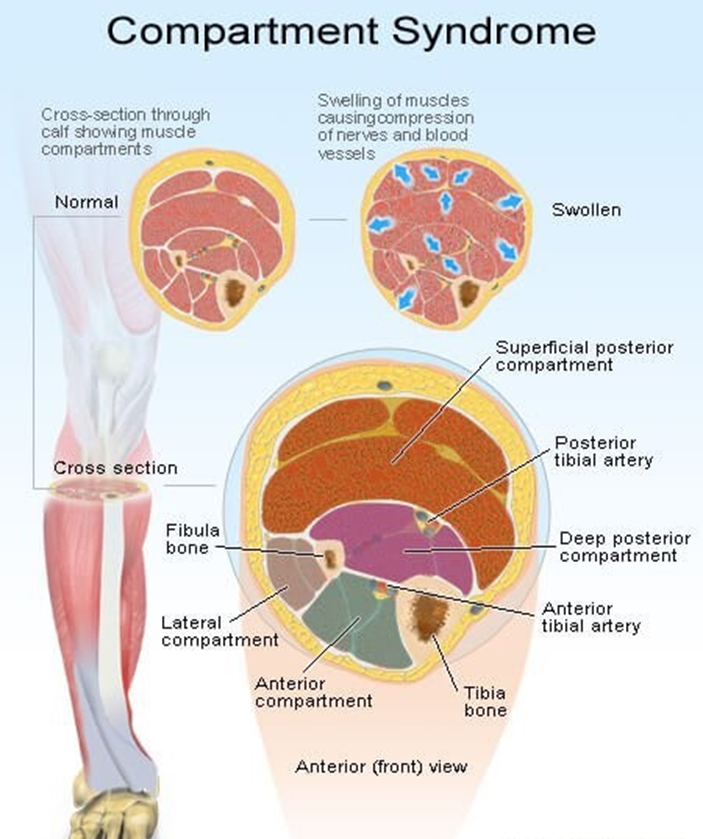The nurse is caring for a client who develops compartment syndrome from a severely fractured arm. The client asks the nurse why this can happen. What is the best response by the nurse?
A bone fragment has injured the nerve supply in the area.
An injured artery causes impaired arterial perfusion through the compartment.
Bleeding and swelling cause increased pressure in an area that cannot expand.
The fascia expands with injury, causing pressure on underlying nerves and muscles.
The Correct Answer is C
Choice A reason: A bone fragment has injured the nerve supply in the area is not the best response by the nurse. This may be a possible complication of a fracture, but it does not explain the mechanism of compartment syndrome. Compartment syndrome is a condition where the pressure within a closed space (such as a muscle compartment) exceeds the perfusion pressure and causes ischemia and necrosis of the tissues. A bone fragment may damage the nerve, but it does not cause increased pressure in the compartment.
Choice B reason: An injured artery causes impaired arterial perfusion through the compartment is not the best response by the nurse. This may be a possible cause of compartment syndrome, but it is not the most common one. Compartment syndrome is more often caused by venous obstruction than arterial obstruction. An injured artery may reduce the blood flow to the compartment, but it does not cause increased pressure in the compartment.
Choice C reason: Bleeding and swelling cause increased pressure in an area that cannot expand is the best response by the nurse. This is the most common cause of compartment syndrome and explains the pathophysiology of the condition. Bleeding and swelling are the result of inflammation and tissue injury that occur after a fracture. They increase the volume of fluid in the compartment, which cannot expand due to the rigid fascia that surrounds it. This leads to increased pressure in the compartment, which compresses the blood vessels, nerves, and muscles and causes ischemia and necrosis of the tissues.
Choice D reason: The fascia expands with injury, causing pressure on underlying nerves and muscles is not the best response by the nurse. This is not a correct statement, as the fascia does not expand with injury. The fascia is a tough connective tissue that encloses the muscle compartments and limits their expansion. The fascia is part of the problem, not the cause, of compartment syndrome. The fascia prevents the compartment from accommodating the increased volume of fluid and causes increased pressure in the compartment.

Nursing Test Bank
Naxlex Comprehensive Predictor Exams
Related Questions
Correct Answer is ["A","C","E"]
Explanation
Choice A reason: Increased agitation is a nonverbal sign of pain, because it indicates that the client is restless, uncomfortable, or distressed by the pain. Agitation can manifest as fidgeting, tossing, turning, moaning, or groaning.
Choice B reason: Decreased attention span is not a nonverbal sign of pain, but rather a cognitive or behavioral sign of pain. Decreased attention span means that the client has difficulty focusing, concentrating, or remembering things, which can be affected by pain. However, decreased attention span is not a direct expression of pain, but rather a consequence of pain.
Choice C reason: Grimacing is a nonverbal sign of pain, because it indicates that the client is experiencing facial muscle tension, contraction, or distortion due to the pain. Grimacing can manifest as frowning, wrinkling the forehead, pursing the lips, or clenching the teeth.
Choice D reason: Reported pain of 5/10 is not a nonverbal sign of pain, but rather a verbal sign of pain. Reported pain of 5/10 means that the client has communicated the intensity of their pain using a numerical scale, which is a subjective and selfreported measure of pain. However, reported pain of 5/10 is not a direct expression of pain, but rather a description of pain.
Choice E reason: Increase in heart rate is a nonverbal sign of pain, because it indicates that the client is experiencing physiological changes due to the pain. Increase in heart rate can manifest as tachycardia, palpitations, or arrhythmias.
Correct Answer is D
Explanation
Choice A reason: The client instills the prescribed number of eye drops into the conjunctival sac is a correct action, because it ensures that the medication reaches the eye surface and does not spill out. The conjunctival sac is the space between the eyelid and the eyeball.
Choice B reason: The client washes her hands before instilling the eye drops is a correct action, because it prevents the introduction of microorganisms or foreign substances into the eye. Hand hygiene is an essential infection control measure.
Choice C reason: The client sets the cap to the eye drop container down in a manner that does not contaminate it is a correct action, because it preserves the sterility of the eye drop solution and prevents crosscontamination. The cap should be placed on a clean surface with the inner side facing up.
Choice D reason: The client touches the administration dropper to the eye is an incorrect action, because it can cause injury, infection, or contamination of the eye drop solution. The administration dropper should be held close to the eye, but not touch it.
Whether you are a student looking to ace your exams or a practicing nurse seeking to enhance your expertise , our nursing education contents will empower you with the confidence and competence to make a difference in the lives of patients and become a respected leader in the healthcare field.
Visit Naxlex, invest in your future and unlock endless possibilities with our unparalleled nursing education contents today
Report Wrong Answer on the Current Question
Do you disagree with the answer? If yes, what is your expected answer? Explain.
Kindly be descriptive with the issue you are facing.
